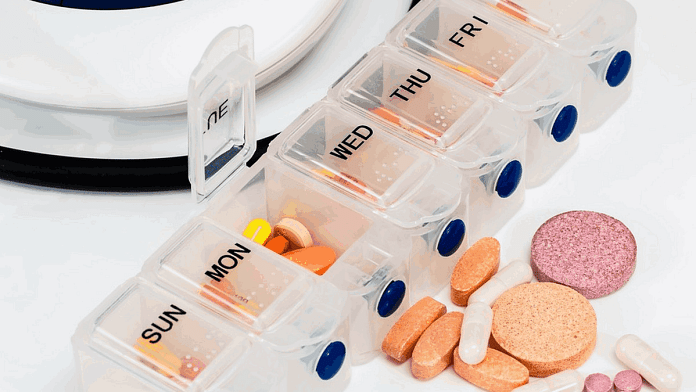New Delhi: Over 50 percent of antibiotics prescribed in India are those with a potential to cause high antimicrobial resistance, according to a government report based on India’s first large-scale multi-centric study on the use of the medicines. The report calls this a “concerning trend”.
The First Multicentric Point Prevalence Survey of Antibiotic Use at 20 NAC-NET Sites India 2021-22 was conducted by the National Centre for Disease Control (NCDC) under the Union health ministry.
The report was released Tuesday.
The National Antimicrobial Consumption Network (NAC-NET) consists of 35 tertiary-care institutes across India, and has been monitoring antibiotic consumption at these facilities for the past five years.
According to the report, a copy of which is with ThePrint, the survey findings indicate a “remarkably high prevalence” of antibiotic usage (71.9 percent), with 4.6 percent of the patients getting four or more antibiotics.
Out of the 20 sites where the assessment was carried out, four had more than 95 percent prevalence of antibiotic use, the report says, before offering a breakdown of the types prescribed (‘watch’ or ‘access’).
According to the AWaRe classification of antibiotics developed by the World Health Organization (WHO) in 2017, ‘watch’ antibiotics generally have a higher potential for antimicrobial resistance, and are more commonly used in sicker patients in medical facilities.
These medicines, according to the world health body, should be prescribed carefully to avoid misuse.
Access antibiotics are those with a narrow spectrum of activity, generally with fewer side-effects, and a lower potential for antimicrobial resistance and lower cost.
These are recommended for the empiric treatment of most common infections.
The classification also includes a third group — ‘reserve’ antibiotics — that are last-resort medicines and should only be used to treat severe infections caused by multidrug-resistant pathogens.
The government survey found that, at 57 percent, ‘watch’ group antibiotics were on average prescribed more frequently at the 20 sites, than those under ‘access’ (38 percent). The trend was the other way round at two sites.
In 2019, the WHO included antimicrobial resistance as one of the top 10 threats to public health.
The report says that the discovery of antibiotics has been a groundbreaking advancement that revolutionised the approach to infectious diseases, but these “once-miraculous drugs” have become less effective due to various factors.
“One of these factors is the indiscriminate, excessive, and inappropriate use of antibiotics,” it says.
Also Read: 70% of antibiotic fixed-dose combination drugs sold in India unapproved or banned, finds study
Overview of the results
Funded by the WHO, the study was conducted over six months from November 2021 to April 2022. The number of survey days ranged from 1 to 5 for each health facility. A total of 9,562 patients were covered.
The results showed that third-generation ‘cephalosporins’ — antibiotics first derived from the fungus Cephalosporium acremonium, and used to treat a wide variety of infections — were the most commonly prescribed class of antibiotics (33.1 percent).
The top antibiotics being prescribed across classes are the molecules Ceftriaxone, Metronidazole and Amikacin.
Almost a quarter of the patients on antibiotics (26.4 percent) were on double cover (two antibiotics) from gram-negative bacteria, which are more resistant to medicines as compared to gram-positive bacteria.
More than half of the patients were prescribed antibiotics for prophylactic (to prevent disease) indications, with 91 percent receiving surgical prophylaxis — antibiotics used for preventing infection of a surgical site — for more than one day.
Also, in the selected institutes, only 6 per of patients on antibiotics were put on definitive therapy, and the stop date was recorded in only 10.4 percent prescriptions.
The report notes that only 8 out of the 20 institutes have an antibiotic policy in place.
The knowledge gained from this survey, the report says, will serve as a foundation for future point prevalence surveys, and will play a vital role in establishing and evaluating the effectiveness of antimicrobial stewardship programmes, “consequently, optimising the utilisation of antibiotics in human health, in accordance with the National Action Plan on Antimicrobial Resistance Containment in the country”.
Based on the findings, the report adds that health facilities should adhere to standard treatment guidelines and infection-control practices to mitigate antibiotic resistance. Also, it recommends that hospitals develop a well-defined antibiotic policy that encourages use of access-group antibiotics.
“Institutions should aim to keep the consumption of reserve group antibiotics at low levels and monitor the usage of reserve- group drugs obtained from outside the hospital pharmacy,” it says.
The institutions have also been advised to share the results of the study with physicians to effect changes in their prescribing behaviours.
Polypharmacy (use of multiple drugs to treat a single condition), it says, was observed in all the institutions, highlighting that combining two antibiotics can increase the risk of adverse effects.
Therefore, institutions have been asked to avoid unnecessary double coverage with antibiotics for anaerobic bacteria and gram-negative bacteria.
The study also found the use of antibiotics “not recommended” by the WHO, and the report urges hospitals to monitor the consumption of such drugs closely.
Surgical prophylaxis, it adds, should be limited to a single dose or a day before the surgical procedure, and treatment for post-procedure infections should only be administered after a diagnosis of infection.
(Edited by Sunanda Ranjan)
Also Read: What is antibiotic resistance and how we can tackle it



